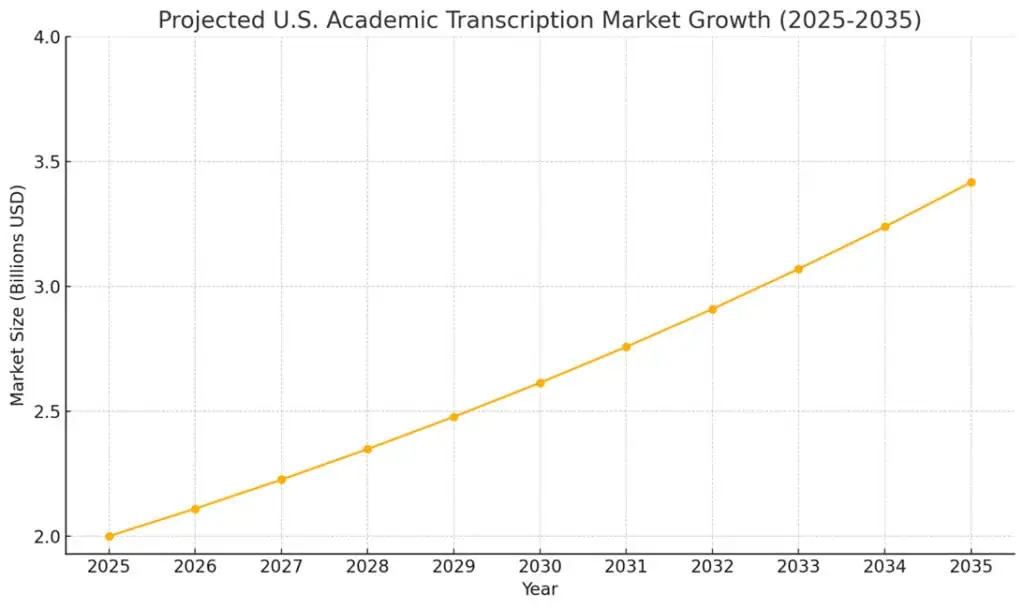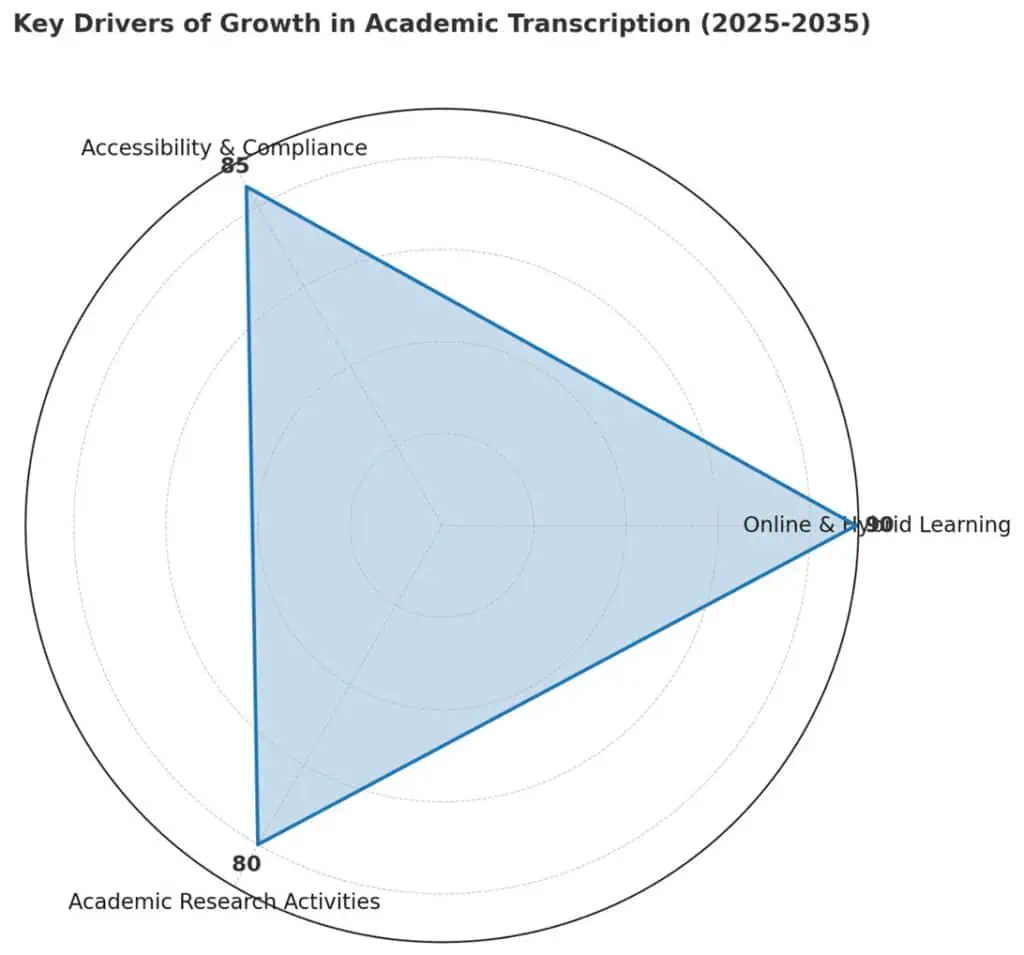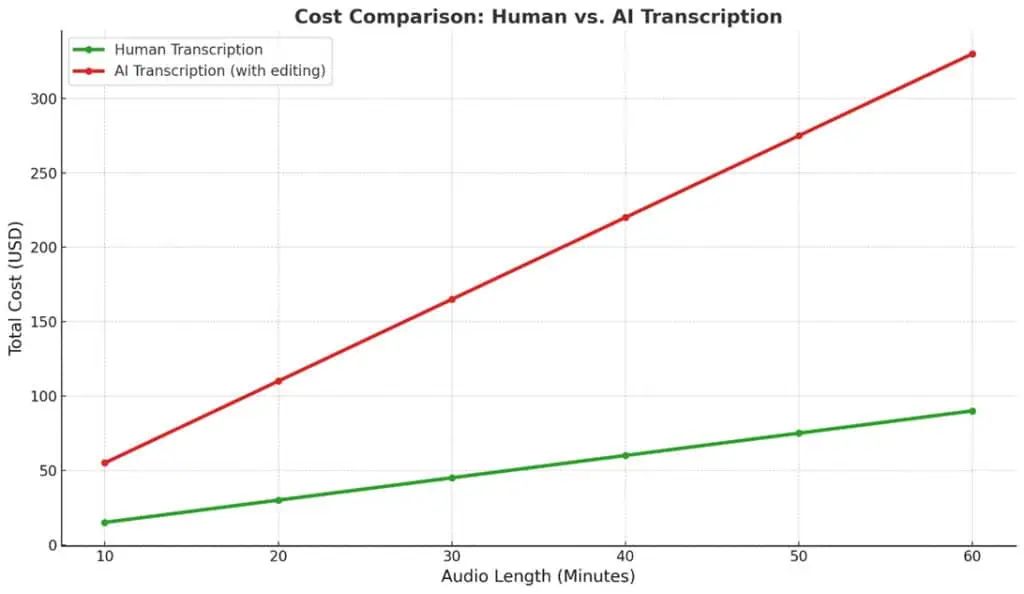
Academic transcription involves turning spoken content into written form, typically used for class lectures, student interviews, research studies, and panel events. These transcripts provide students and professors with clear, accurate notes to study and reference. Many higher education institutions have adopted academic transcription services as a standard part of their online courses. Accurate transcripts benefit everyone by ensuring equal access for students with hearing issues or those learning English as a second language.
In 2025, the higher education landscape in the United States continues to move toward digital learning methods. More students and faculty now rely on recorded lectures and remote class sessions. The growing use of digital classrooms has increased demand for accurate lecture notes, video captions, and searchable academic resources. At the same time, researchers conducting interviews or discussions prefer having their audio recorded and transcribed for easier analysis.
The emphasis on educational equity has also raised the demand for transcription services at colleges and universities. Schools need to meet strict accessibility guidelines, such as the Americans with Disabilities Act, to ensure all students have fair and equal access. Providing reliable transcripts helps schools meet these guidelines. As educational institutions grow more dependent on digital tools and remote learning, academic transcription services will continue playing a critical role.
Academic Transcription Market Overview and Baseline 2025
In 2025, the academic segment of the U.S. transcription market makes up a growing portion of the overall industry. Educational institutions account for a steady increase in spending on transcripts, as they shift more teaching to online or mixed formats. This transition means schools now regularly need written versions of recorded lectures and interviews. Academic clients include colleges, universities, research centers, and graduate programs throughout the country.
Current estimates place the U.S. transcription market around $30 billion in 2024, and the academic portion is expected to follow a similar upward path. Within academia, colleges and graduate schools lead the growth, especially in research-based fields. Universities increasingly seek professional services to handle interviews, focus groups, and complex lecture materials. Demand from K-12 schools is also rising, although still smaller compared to higher education.
Several factors drive demand in the academic market, including a higher number of international students attending U.S. schools. These students often use transcripts to support their studies and to better understand course materials. Additionally, the ongoing focus on disability services and educational equality makes accurate transcription essential. These factors combine to position the academic transcription market for steady growth from 2025 going forward.
Drivers of Growth in The Academic Transcription Market
Increasing Use of Online and Hybrid Learning
In recent years, U.S. colleges have adopted online learning as a regular part of their course offerings. Many students and professors prefer courses that blend online instruction with classroom lessons. Because of this, institutions record more lectures and discussions, increasing the need for accurate and timely transcripts. The ongoing shift toward online education is one of the main forces driving the growth in academic transcription.
Accessibility and Compliance Requirements
Schools must comply with federal rules, including the Americans with Disabilities Act, which requires providing equal access to learning. Transcripts offer critical support to students who have hearing difficulties or who do not speak English as their first language. Clear written versions of lectures ensure every student can fully engage with class materials. With an increased focus on equal access, colleges are relying more heavily on transcription providers who can guarantee accuracy and reliability.
Growing Demand for Transcription Services from Academic Research Activities
Universities and colleges conduct thousands of research projects and student studies each year. These often include recorded interviews, discussions, and group sessions. Researchers find transcripts valuable because written records make it easier to organize information and draw conclusions. As academic research continues to expand, especially in social sciences and healthcare fields, the demand for professional research transcription services will grow alongside it.

Academic Transcription Services Market Forecast 2025 to 2035
Projected Growth and Expansion
Between 2025 and 2035, the academic transcription market is expected to grow steadily, closely matching broader industry patterns. Annual growth will average around 5.5 percent due to ongoing demand for online learning and accessibility needs. As universities and colleges continue to invest in online education programs, they will consistently require professional transcription services. Growth could become stronger if schools further adopt digital classroom technologies and research activity increases.
Market Size Estimates for 2035
By 2035, the academic transcription services market could more than double, rising above four billion dollars from around two billion dollars in 2025. This projection assumes steady growth driven by both remote learning and federal accessibility rules. If universities widely embrace automated technology combined with human oversight, growth may accelerate further, potentially exceeding these conservative estimates.

Key Challenges and Considerations for the Academic Transcription Services Market
Accuracy versus Cost
One key issue facing schools is balancing the accuracy of transcription against their available budgets. Academic topics often use specific language unique to a subject or field. Transcripts filled with errors can disrupt learning and research efforts. To maintain quality, institutions usually rely on human transcriptionists, which increases costs compared to automated AI transcription systems.
Data Privacy Requirements
Colleges and universities frequently handle sensitive student information and confidential research data. Ensuring transcripts remain private and secure is essential. Schools must confirm transcription providers comply with strict federal and state privacy guidelines. This factor adds another layer of complexity for institutions evaluating potential partners because they have to make sure the sensitive information is secure.
System Integration with Education Tools
Most schools rely on systems like Canvas, Blackboard, or Zoom to manage online courses. Seamlessly linking transcription services with these platforms can be difficult. A lack of smooth integration may discourage some educators from regularly using transcripts and closed captions for the recorded versions of their classes. Providers who offer reliable integration solutions will likely gain significant advantages over their competitors.
Competitive Landscape and Service Positioning for Academic Transcription
The academic transcription market in the U.S. includes three main service models: fully human, fully automated, and mixed approaches. Fully human services provide high accuracy and usually at a greater cost. Fully automated services offer lower prices and at the same time greatly sacrifice accuracy, especially in specialized subject matters or multiple speaker files. Mixed models aim to balance cost and accuracy by combining both methods.
Colleges and universities have distinct needs when choosing a transcription provider. Some prioritize accuracy and will pay extra to ensure fewer mistakes. Others seek affordable options to handle large volumes of basic content. Providers that clearly explain how they deliver accuracy, affordability, or both, have an advantage in capturing institutional clients.
Currently, services known for their accuracy and reliability attract many university and research clients. Providers who smoothly connect with popular classroom software also earn a stronger market position. Over the next decade, those companies that best address schools’ specific needs for accuracy, privacy, and system integration will see continued success.
Recommendations for Providers and Institutions
Academic Transcription Providers
Transcription companies serving academic clients should clearly emphasize accuracy above everything else. While some AI tools promise speed, their accuracy does not match that of skilled human transcriptionists. Often, schools find themselves spending ten minutes editing an AI-generated transcript for every minute of recorded audio. Because of this, transcripts from automated tools can end up costing far more in staff time and effort.
Providers should focus on offering human led transcription services to make sure the accuracy is there for their clients. Highlighting strict quality control processes will help reassure academic clients concerned about mistakes or corrections. Providers should also integrate easily with learning platforms used by colleges and universities, making their services seamless and appealing for schools to adopt.
Academic Institutions Who Need Transcription
Schools should carefully examine accuracy claims when selecting transcription providers. Though automated services might seem affordable at first, the hidden cost of editing AI transcripts can quickly become high. Institutions benefit from partnering with providers that combine expert human transcriptionists with careful quality checks.
Schools should also prioritize providers that easily link to their existing classroom technology. Integrating transcription into systems like Blackboard or Canvas helps faculty and students effortlessly access accurate transcripts. By selecting reliable providers with proven accuracy, educational institutions will save both time and resources in the long term.

Ditto Transcripts is a Denver, Colorado-based transcription company that provides fast, accurate, and affordable transcription services for individuals and companies of all sizes. Call (720) 287-3710 today for a free quote.

